OPEL MOVANO_B 2017.5 Manual user
Manufacturer: OPEL, Model Year: 2017.5, Model line: MOVANO_B, Model: OPEL MOVANO_B 2017.5Pages: 261, PDF Size: 6.26 MB
Page 141 of 261

Driving and operating139Bus
The engine is restarted automatically
when operating the power sliding
door switch on the instrument panel
during an Autostop.
Sliding door 3 28.
Restart of the engine by the stop- start system
If one of the following conditions occurs during an Autostop, the
engine may be restarted
automatically by the stop-start
system. Control indicator Ï will flash
green in the instrument cluster during an automatic engine restart.
● the vehicle battery is discharged
● the ambient temperature is too low
● the defrosting function is activated
● the brake vacuum is not sufficient
● the brake pedal is operated repeatedly
● the vehicle starts to moveAn automatic engine restart may not
be possible if a door or the bonnet is
open.
If an electrical accessory, e.g. a
portable CD player, is connected to
the power outlet, a brief power drop during restart might be noticeable.
If the Infotainment system is active,
audio sound may briefly be reduced
or interrupted during the restart.
Fault
If control indicator Ï illuminates
yellow, or the LED illuminates in
deactivation button Î without first
being pressed to deactivate the
system, there is a fault in the stop-
start system 3 100. A corresponding
message also appears in the Driver
Information Centre 3 102.
Seek the assistance of a workshop. Warning chimes 3 103.Parking9 Warning
● Do not park the vehicle on an
easily ignitable surface. The
high temperature of the
exhaust system could ignite the
surface.
● Always apply parking brake without pressing release
button. Apply as firmly as
possible on a downhill slope or
uphill slope. Depress brake
pedal at the same time to
reduce operating force.
● Switch off the engine.
● If the vehicle is on a level surface or uphill slope, engage
first gear. On an uphill slope,
turn the front wheels away from
the kerb.
If the vehicle is on a downhill
slope, engage reverse gear.
Turn the front wheels towards the kerb.
Page 142 of 261
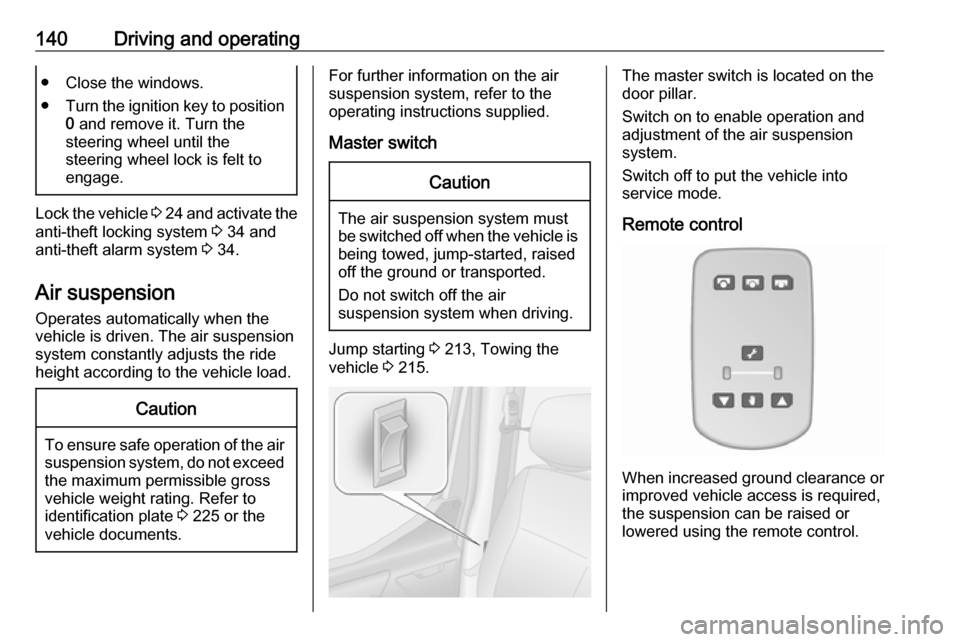
140Driving and operating● Close the windows.
● Turn the ignition key to position
0 and remove it. Turn the
steering wheel until the
steering wheel lock is felt to
engage.
Lock the vehicle 3 24 and activate the
anti-theft locking system 3 34 and
anti-theft alarm system 3 34.
Air suspension
Operates automatically when the
vehicle is driven. The air suspension
system constantly adjusts the ride
height according to the vehicle load.
Caution
To ensure safe operation of the air
suspension system, do not exceed the maximum permissible gross
vehicle weight rating. Refer to
identification plate 3 225 or the
vehicle documents.
For further information on the air
suspension system, refer to the
operating instructions supplied.
Master switchCaution
The air suspension system must
be switched off when the vehicle is being towed, jump‐started, raised
off the ground or transported.
Do not switch off the air
suspension system when driving.
Jump starting 3 213, Towing the
vehicle 3 215.
The master switch is located on the
door pillar.
Switch on to enable operation and
adjustment of the air suspension
system.
Switch off to put the vehicle into
service mode.
Remote control
When increased ground clearance or improved vehicle access is required,the suspension can be raised or
lowered using the remote control.
Page 143 of 261
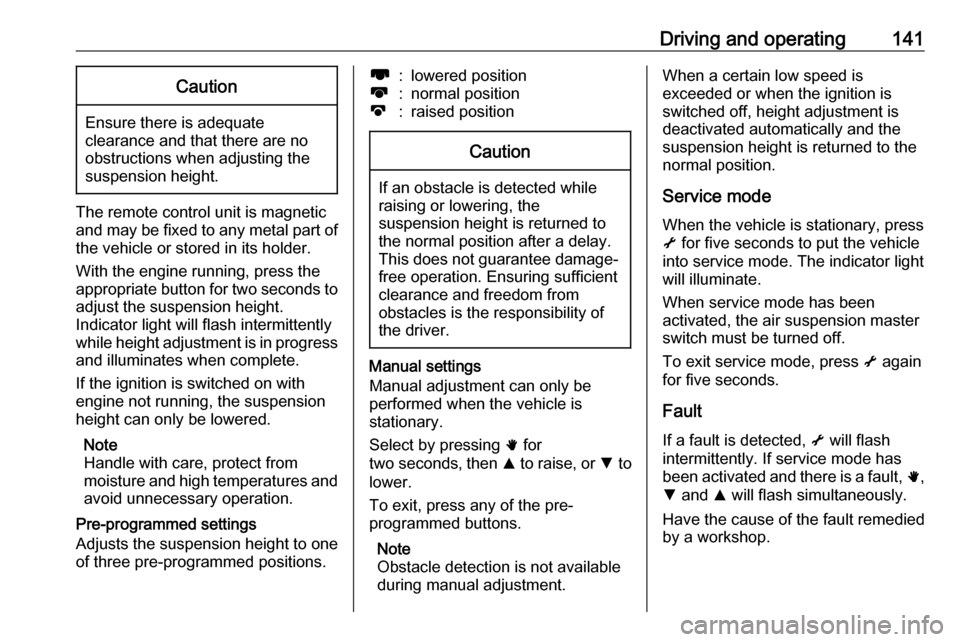
Driving and operating141Caution
Ensure there is adequate
clearance and that there are no
obstructions when adjusting the
suspension height.
The remote control unit is magnetic
and may be fixed to any metal part of the vehicle or stored in its holder.
With the engine running, press the appropriate button for two seconds to
adjust the suspension height.
Indicator light will flash intermittently
while height adjustment is in progress
and illuminates when complete.
If the ignition is switched on with
engine not running, the suspension
height can only be lowered.
Note
Handle with care, protect from
moisture and high temperatures and
avoid unnecessary operation.
Pre-programmed settings
Adjusts the suspension height to one
of three pre-programmed positions.
l:lowered positionk:normal positionj:raised positionCaution
If an obstacle is detected while
raising or lowering, the
suspension height is returned to the normal position after a delay.
This does not guarantee damage- free operation. Ensuring sufficient
clearance and freedom from
obstacles is the responsibility of the driver.
Manual settings
Manual adjustment can only be
performed when the vehicle is
stationary.
Select by pressing h for
two seconds , then R to raise, or S to
lower.
To exit, press any of the pre-
programmed buttons.
Note
Obstacle detection is not available
during manual adjustment.
When a certain low speed is
exceeded or when the ignition is
switched off, height adjustment is deactivated automatically and the
suspension height is returned to the
normal position.
Service modeWhen the vehicle is stationary, press
i for five seconds to put the vehicle
into service mode. The indicator light
will illuminate.
When service mode has been
activated, the air suspension master
switch must be turned off.
To exit service mode, press i again
for five seconds.
Fault
If a fault is detected, i will flash
intermittently. If service mode has been activated and there is a fault, h,
S and R will flash simultaneously.
Have the cause of the fault remedied
by a workshop.
Page 144 of 261
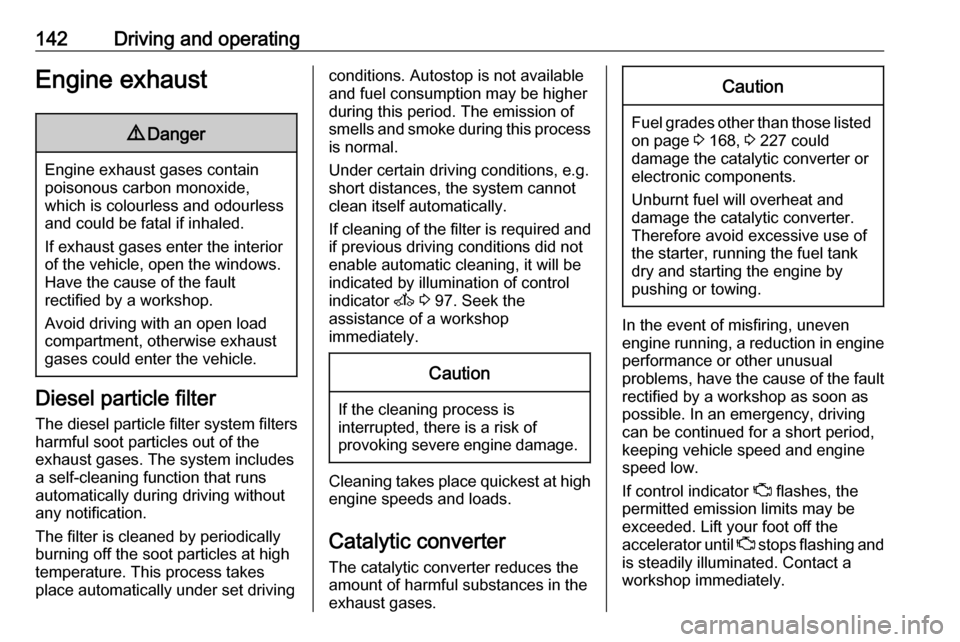
142Driving and operatingEngine exhaust9Danger
Engine exhaust gases contain
poisonous carbon monoxide,
which is colourless and odourless and could be fatal if inhaled.
If exhaust gases enter the interior
of the vehicle, open the windows.
Have the cause of the fault
rectified by a workshop.
Avoid driving with an open load
compartment, otherwise exhaust
gases could enter the vehicle.
Diesel particle filter
The diesel particle filter system filters
harmful soot particles out of the
exhaust gases. The system includes
a self-cleaning function that runs
automatically during driving without
any notification.
The filter is cleaned by periodically
burning off the soot particles at high
temperature. This process takes
place automatically under set driving
conditions. Autostop is not available
and fuel consumption may be higher
during this period. The emission of
smells and smoke during this process is normal.
Under certain driving conditions, e.g.
short distances, the system cannot
clean itself automatically.
If cleaning of the filter is required and
if previous driving conditions did not
enable automatic cleaning, it will be
indicated by illumination of control
indicator A 3 97. Seek the
assistance of a workshop
immediately.Caution
If the cleaning process is
interrupted, there is a risk of
provoking severe engine damage.
Cleaning takes place quickest at high engine speeds and loads.
Catalytic converter
The catalytic converter reduces the
amount of harmful substances in the
exhaust gases.
Caution
Fuel grades other than those listed on page 3 168, 3 227 could
damage the catalytic converter or
electronic components.
Unburnt fuel will overheat and
damage the catalytic converter.
Therefore avoid excessive use of the starter, running the fuel tank
dry and starting the engine by
pushing or towing.
In the event of misfiring, uneven
engine running, a reduction in engine performance or other unusual
problems, have the cause of the fault
rectified by a workshop as soon as
possible. In an emergency, driving
can be continued for a short period,
keeping vehicle speed and engine
speed low.
If control indicator Z flashes, the
permitted emission limits may be
exceeded. Lift your foot off the
accelerator until Z stops flashing and
is steadily illuminated. Contact a
workshop immediately.
Page 145 of 261
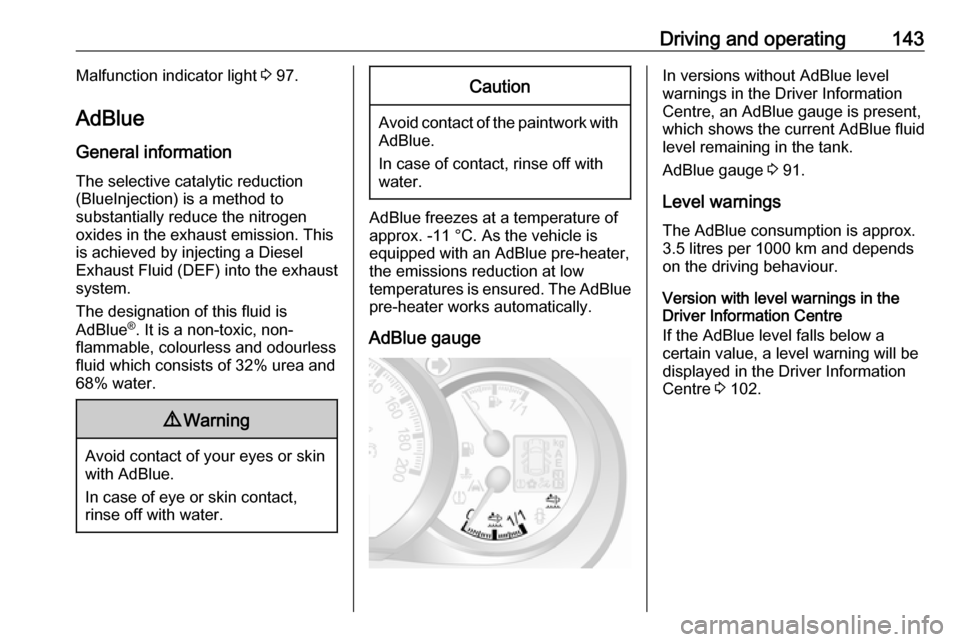
Driving and operating143Malfunction indicator light 3 97.
AdBlue
General information The selective catalytic reduction
(BlueInjection) is a method to
substantially reduce the nitrogen
oxides in the exhaust emission. This
is achieved by injecting a Diesel
Exhaust Fluid (DEF) into the exhaust
system.
The designation of this fluid is
AdBlue ®
. It is a non-toxic, non-
flammable, colourless and odourless
fluid which consists of 32% urea and
68% water.9 Warning
Avoid contact of your eyes or skin
with AdBlue.
In case of eye or skin contact,
rinse off with water.
Caution
Avoid contact of the paintwork with AdBlue.
In case of contact, rinse off with water.
AdBlue freezes at a temperature of
approx. -11 °C. As the vehicle is
equipped with an AdBlue pre-heater,
the emissions reduction at low
temperatures is ensured. The AdBlue
pre-heater works automatically.
AdBlue gauge
In versions without AdBlue level
warnings in the Driver Information
Centre, an AdBlue gauge is present,
which shows the current AdBlue fluid
level remaining in the tank.
AdBlue gauge 3 91.
Level warnings
The AdBlue consumption is approx.
3.5 litres per 1000 km and depends
on the driving behaviour.
Version with level warnings in the
Driver Information Centre
If the AdBlue level falls below a
certain value, a level warning will be
displayed in the Driver Information
Centre 3 102.
Page 146 of 261

144Driving and operating
Additionally, control indicator Õ
illuminates continuously together with a warning chime.
Refill the AdBlue tank as soon as
possible. Refer to "Refilling AdBlue"
below.
If AdBlue is not refilled within a certain
distance, further level warnings are
displayed in the Driver Information
Centre depending on the current
AdBlue level.
Engine restarts prevented
Subsequent requests to refill AdBlue
and finally the announcement that an engine restart will be prevented are
displayed in the Driver Information
Centre.Note
These restrictions are a legal
requirement.
Before the prevention of an engine
restart, a warning message with
0 km is displayed in the Driver
Information Centre, indicating that after switching off the ignition an
engine restart will be prohibited.
After the prevention of an engine
start, a warning message is displayed in the Driver Information Centre
reminding the driver that AdBlue level
is insufficient.
To allow the engine to be restarted,
the tank should be refilled completely
or with a volume of at least ten litres
of AdBlue, depending on AdBlue
consumption.Warning stages: level warnings,
engine restarts prevented 1. Y illuminates after the ignition is
switched on with warning
message LEVEL ADBLUE LOW :
Driving is possible without any
restrictions.
Refill the AdBlue tank as soon as
possible.2. Y illuminates during driving with
warning message TOP UP
ADBLUE :
Possible loss of engine power.
Refill the AdBlue tank as soon as
possible.
3. Y illuminates during driving with
warning message XXX KM STOP
ADD ADBLUE :
Vehicle speed may be limited to
20 km/h after switching the engine
off and on again until the range is
reduced to 0 km.
Refill the tank completely or with a volume of at least ten litres of
AdBlue (depending on AdBlue
consumption) as soon as
possible.
4. Y illuminates during driving with
warning message 0 KM STOP
ADD ADBLUE :
The engine cannot be restarted
after switching off the ignition.
To allow the engine to be
restarted, refill the tank
completely or with a volume of at
least ten litres of AdBlue
(depending on AdBlue
Page 147 of 261

Driving and operating145consumption) as soon as
possible.
Illumination of control indicator Y may
be accompanied by a warning chime.
Warning chimes 3 103.High emission warnings
If the exhaust emission rises above a
certain value, warnings similar to the
range warnings as described above
will be displayed in the Driver
Information Centre. Control indicator
Õ illuminates continuously together
with A 3 97 and a warning chime.
Requests to have the exhaust system checked and finally the
announcement that an engine restart
will be prevented are displayed in the Driver Information Centre.
Note
These restrictions are a legal
requirement.
At an AdBlue range of 1100 km, a
warning message is displayed in the
Driver Information Centre showing
the remaining distance the vehicle
can travel before engine restarts are
prevented. This warning message is
repeated every 100 km.Seek the assistance of a workshop as
soon as possible.Warning stages: high emission
warnings 1. Y and A illuminate with warning
message CHECK ANTI-
POLLUTION :
Fault in the system that may result in a loss of engine power.
Seek the assistance of a
workshop as soon as possible.
2. Y and A illuminate with warning
message ANTIPOLLUTION xxx
KM FAIL :
Indicates that in less than 1100 km an engine restart will be
prohibited after switching off the
ignition.
This warning message will be
repeated every 100 km.
Vehicle speed may be limited to
20 km/h after switching the engine
off and on again until the range is
reduced to 0 km.Seek the assistance of a
workshop as soon as possible.
3. Y and A illuminate with warning
message ANTIPOLLUTION 0 KM
FAILURE :
The engine cannot be restarted
after switching off the ignition.
Seek the assistance of a
workshop.
Illumination of control indicators Y
and A may be accompanied by a
warning chime.
Warning chimes 3 103.
Version without level warnings in the Driver Information Centre
Page 148 of 261
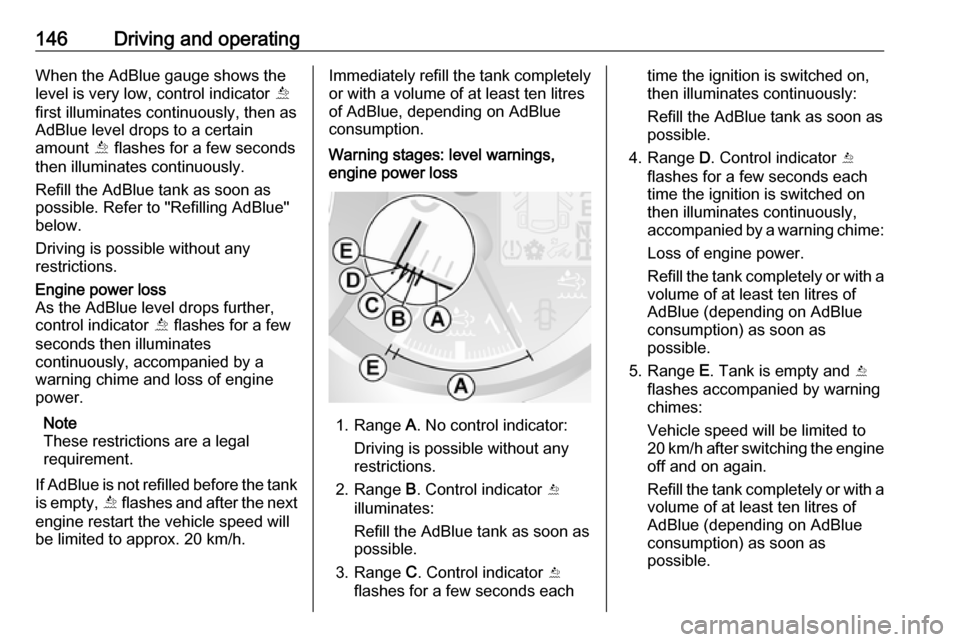
146Driving and operatingWhen the AdBlue gauge shows the
level is very low, control indicator Õ
first illuminates continuously, then as
AdBlue level drops to a certain
amount Õ flashes for a few seconds
then illuminates continuously.
Refill the AdBlue tank as soon as
possible. Refer to "Refilling AdBlue"
below.
Driving is possible without any
restrictions.Engine power loss
As the AdBlue level drops further,
control indicator Õ flashes for a few
seconds then illuminates
continuously, accompanied by a
warning chime and loss of engine
power.
Note
These restrictions are a legal
requirement.
If AdBlue is not refilled before the tank
is empty, Õ flashes and after the next
engine restart the vehicle speed will
be limited to approx. 20 km/h.Immediately refill the tank completely or with a volume of at least ten litres
of AdBlue, depending on AdBlue
consumption.Warning stages: level warnings,
engine power loss
1. Range A. No control indicator:
Driving is possible without any
restrictions.
2. Range B. Control indicator Y
illuminates:
Refill the AdBlue tank as soon as
possible.
3. Range C. Control indicator Y
flashes for a few seconds each
time the ignition is switched on,
then illuminates continuously:
Refill the AdBlue tank as soon as
possible.
4. Range D. Control indicator Y
flashes for a few seconds each
time the ignition is switched on
then illuminates continuously,
accompanied by a warning chime:
Loss of engine power.
Refill the tank completely or with a
volume of at least ten litres of
AdBlue (depending on AdBlue
consumption) as soon as
possible.
5. Range E. Tank is empty and Y
flashes accompanied by warning chimes:
Vehicle speed will be limited to
20 km/h after switching the engine
off and on again.
Refill the tank completely or with a
volume of at least ten litres of
AdBlue (depending on AdBlue
consumption) as soon as
possible.
Page 149 of 261
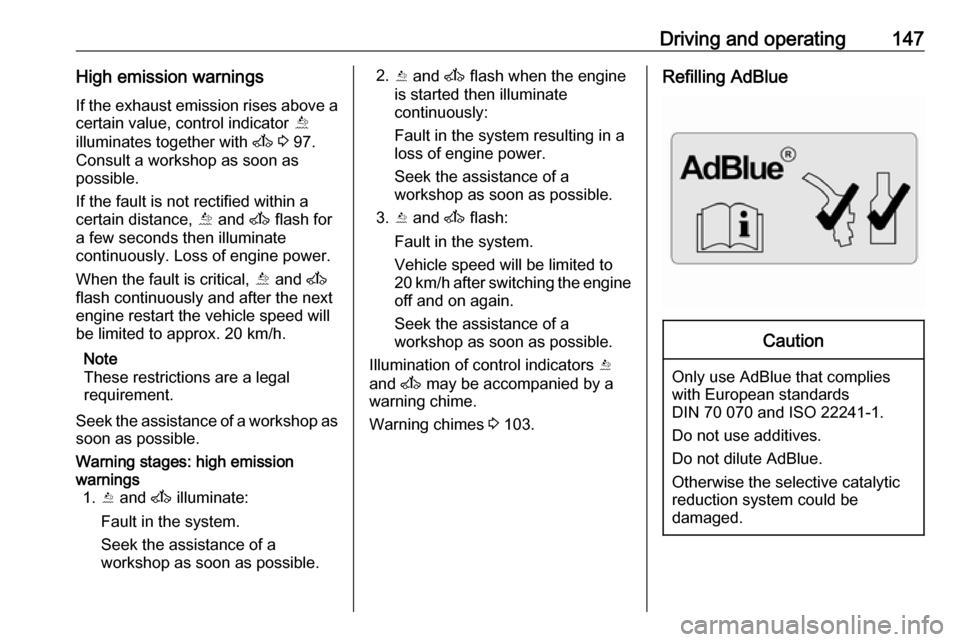
Driving and operating147High emission warningsIf the exhaust emission rises above a
certain value, control indicator Õ
illuminates together with A 3 97.
Consult a workshop as soon as
possible.
If the fault is not rectified within a certain distance, Õ and A flash for
a few seconds then illuminate
continuously. Loss of engine power.
When the fault is critical, Õ and A
flash continuously and after the next
engine restart the vehicle speed will
be limited to approx. 20 km/h.
Note
These restrictions are a legal
requirement.
Seek the assistance of a workshop as soon as possible.Warning stages: high emission
warnings 1. Y and A illuminate:
Fault in the system.
Seek the assistance of a
workshop as soon as possible.2. Y and A flash when the engine
is started then illuminate
continuously:
Fault in the system resulting in a
loss of engine power.
Seek the assistance of a
workshop as soon as possible.
3. Y and A flash:
Fault in the system.
Vehicle speed will be limited to
20 km/h after switching the engine
off and on again.
Seek the assistance of a
workshop as soon as possible.
Illumination of control indicators Y
and A may be accompanied by a
warning chime.
Warning chimes 3 103.Refilling AdBlueCaution
Only use AdBlue that complies
with European standards
DIN 70 070 and ISO 22241-1.
Do not use additives.
Do not dilute AdBlue.
Otherwise the selective catalytic
reduction system could be
damaged.
Page 150 of 261
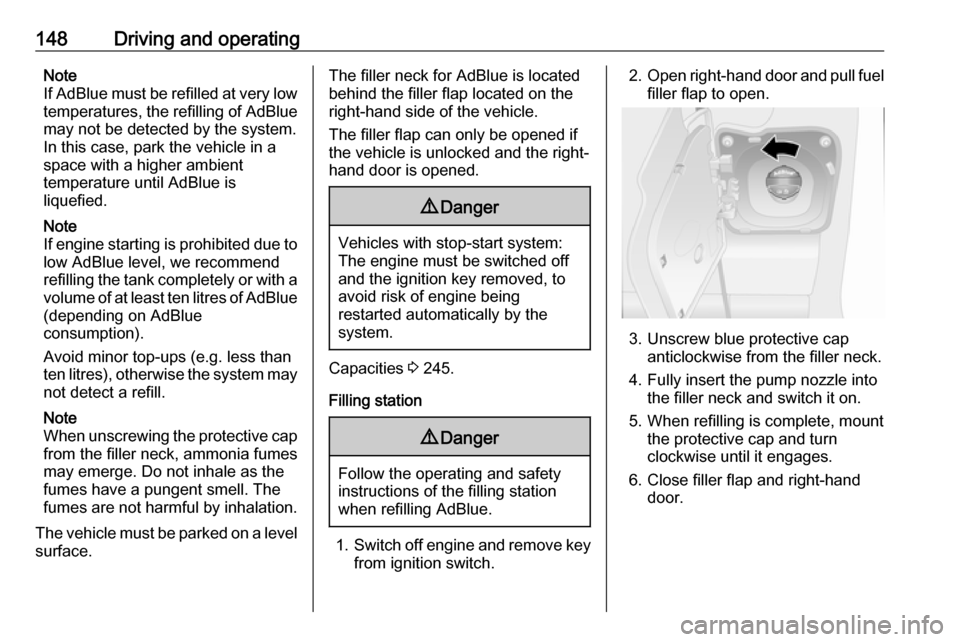
148Driving and operatingNote
If AdBlue must be refilled at very low temperatures, the refilling of AdBlue
may not be detected by the system.
In this case, park the vehicle in a
space with a higher ambient
temperature until AdBlue is
liquefied.
Note
If engine starting is prohibited due to low AdBlue level, we recommend
refilling the tank completely or with a volume of at least ten litres of AdBlue(depending on AdBlue
consumption).
Avoid minor top-ups (e.g. less than
ten litres), otherwise the system may
not detect a refill.
Note
When unscrewing the protective cap from the filler neck, ammonia fumes
may emerge. Do not inhale as the fumes have a pungent smell. The
fumes are not harmful by inhalation.
The vehicle must be parked on a level
surface.The filler neck for AdBlue is located
behind the filler flap located on the
right-hand side of the vehicle.
The filler flap can only be opened if
the vehicle is unlocked and the right-
hand door is opened.9 Danger
Vehicles with stop-start system:
The engine must be switched off
and the ignition key removed, to
avoid risk of engine being
restarted automatically by the
system.
Capacities 3 245.
Filling station
9 Danger
Follow the operating and safety
instructions of the filling station
when refilling AdBlue.
1. Switch off engine and remove key
from ignition switch.
2. Open right-hand door and pull fuel
filler flap to open.
3. Unscrew blue protective cap anticlockwise from the filler neck.
4. Fully insert the pump nozzle into the filler neck and switch it on.
5. When refilling is complete, mount the protective cap and turn
clockwise until it engages.
6. Close filler flap and right-hand door.